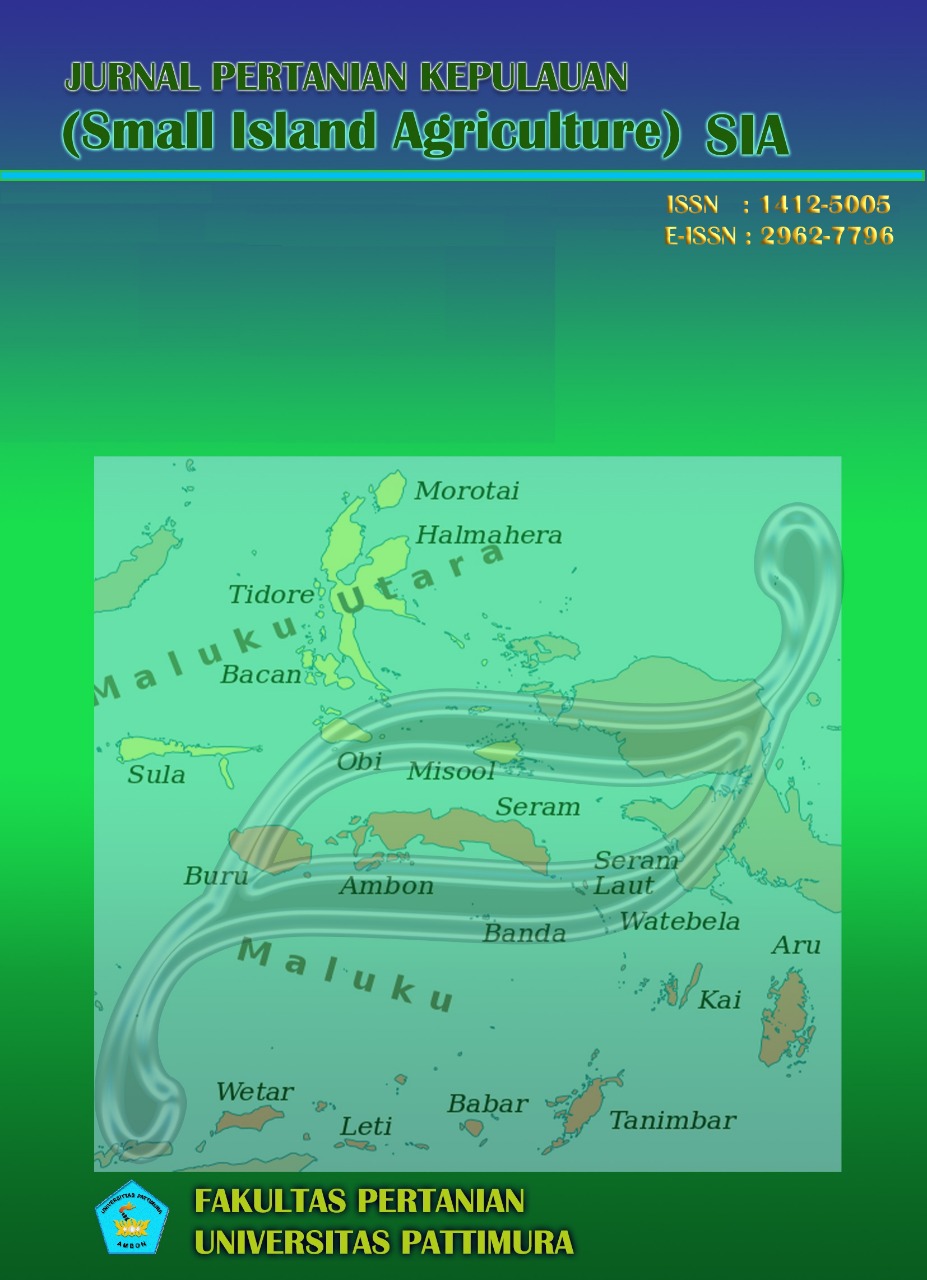Pengaruh Konsentrasi Ragi (Rhizopus oligosporus) terhadap Karakteristik Kimia Tempe Kenari (Canarium indicum)
Abstract
Kenari (Canarium indicum) has high potential as a raw material for tempeh due to its rich nutritional content and functional value. This study aimed to evaluate the effect of yeast concentration on the chemical and organoleptic characteristics of kenari tempeh and determine the optimal yeast concentration for producing high-quality tempeh. A Completely Randomized Design was employed with four yeast concentration treatments (0.5%, 1.5%, 2.5%, and 3.5%), each replicated three times. The analysis included chemical parameters (moisture, ash, protein, fat, fiber, and carbohydrate content) and organoleptic evaluation. The results indicated that yeast concentration significantly affected all chemical parameters of kenari tempeh. A 0.5% yeast concentration produced the best chemical characteristics, with a moisture content of 31.80%, ash content of 1.66%, protein content of 8.90%, fat content of 45.52%, fiber content of 3.38%, and carbohydrate content of 10.27%. Meanwhile, yeast concentration did not affect the organoleptic characteristics of color and appearance but significantly influenced taste, texture, aroma, and overall acceptability. The 0.5% yeast concentration resulted in kenari tempeh with the highest panelist acceptance, with a "like" score for taste, texture, aroma, and overall, and a "somewhat like" score for color and appearance. The hedonic quality of kenari tempeh exhibited fairly uniform color consistency, strong kenari flavor, soft texture in the mouth, and a distinctive fermented aroma. In conclusion, the 0.5% yeast concentration is the optimal choice for producing kenari tempeh with the best chemical and organoleptic characteristics, supporting the diversification of local food products based on kenari.
Downloads
References
Brian, B. (2018). Effect of fermentation time and starter culture on the functional properties of tempe. https://consensus.app/papers/effect-of-fermentation-time-and-starter-culture-on-the-brian/665bc3a63f5a5ced99561783709fb3f5/
Darni, J., & Wahyuningsih, R. (2023). Tuna, Tempe, and Moora-Based Nuggets Prevent Stunting: Organoleptic Tests, Water Content, and ASH Content. Jurnal Gizi Prima (Prime Nutrition Journal), 8(2). https://doi.org/10.32807/jgp.v8i2.430
Drabo, M., Savadogo, A., & Raes, K. (2023). Effects of tempeh fermentation using Rhizopus oryzae on the nutritional and flour technological properties of Zamnè (Senegalia macrostachya seeds): Exploration of processing alternatives for a hard-to-cook but promising wild legume. Food Bioscience. https://doi.org/10.1016/j.fbio.2023.102823
Dwiatmaka, Y., Yuniarti, N., Lukitaningsih, E., & Wahyuono, S. (2022). Fermentation of soybean seeds using rhizopus oligosporus for tempeh production and standardization based on isoflavones content. International Journal of Applied Pharmaceutics, 14(6). https://doi.org/10.22159/ijap.2022v14i6.43785
Elhalis, H., Chin, X. H., & Chow, Y. (2023). Soybean fermentation: Microbial ecology and starter culture technology. Critical Reviews in Food Science and Nutrition, 64, 7648–7670. https://doi.org/10.1080/10408398.2023.2188951
Handoyo, T., & Morita, N. (2006). Structural and functional properties of fermented soybean (Tempeh) by using rhizopus oligosporus. International Journal of Food Properties, 9(2). https://doi.org/10.1080/10942910500224746
Krisdianilo, V., Siregar, S., & Rizky, V. A. (2021). Karakterisasi dan identifikasi molekuler bakteri penghasil enzim protease dari tempe yang diperjualbelikan di pasar LUBUK PAKAM. JURNAL FARMASIMED (JFM). https://doi.org/10.35451/jfm.v4i1.616
Mailoa, M., Widyaningsih, T. D., Putri, W. D. R., & Harijono. (2019). Fresh and roasted canarium nut (Canarium vulgare) altering the lipid profile of hypercholesterolemic rats (rattus norvegicus). EurAsian Journal of BioSciences, 13(1).
Puspitasari, D., Nasir, Muh., & Azmin, N. (2022). Uji Organoleptik Tempe Dari Biji Asam (Tamarindus indica) Berdasarkan Waktu Fermentasi. JUSTER : Jurnal Sains Dan Terapan, 1(1). https://doi.org/10.55784/juster.vol1.iss1.12
Rizal, S., Kustyawati, M. E., Suharyono, A. S., & Suyarto, V. A. (2022). Changes of nutritional composition of tempeh during fermentation with the addition of Saccharomyces cerevisiae. Biodiversitas, 23(3). https://doi.org/10.13057/biodiv/d230345
Stodolak, B., Starzyńska-Janiszewska, A., & Mickowska, B. (2013). Effect of flaxseed oil-cake addition on the nutritional value of grass pea tempeh. Food Science and Technology Research, 19(6). https://doi.org/10.3136/fstr.19.1107
Tamam, B. (2022). Tempe: Pangan Lokal Unggul (Superfood) Khasanah Budaya Bangsa. Indonesian Red Crescent Humanitarian Journal, 1(1). https://doi.org/10.56744/irchum.v1i1.14
Teoh, S. Q., Chin, N. L., Chong, C. W., Ripen, A. M., How, S., & Lim, J. J. L. (2024). A review on health benefits and processing of tempeh with outlines on its functional microbes. In Future Foods (Vol. 9). https://doi.org/10.1016/j.fufo.2024.100330
Tuhumury, H. C. D., Souripet, A., & Pattiwael, K. J. (2023). Production of Canarium (Canarium indicum L) Butter with Different Sugar Concentrations. Journal of Applied Agricultural Science and Technology, 7(2). https://doi.org/10.55043/jaast.v7i2.138
Wang, H., Sun, C., Yang, S., Ruan, Y., Lyu, L., Guo, X., Wu, X., & Chen, Y. (2023). Exploring the impact of initial moisture content on microbial community and flavor generation in Xiaoqu baijiu fermentation. Food Chemistry: X, 20. https://doi.org/10.1016/j.fochx.2023.100981
Wang, X., Li, F., Zhang, N., Ungerfeld, E., Guo, L., Zhang, X., & Wang, M. (2022). Effects of Supplementing A Yeast Culture in a Pelleted Total Mixed Ration on Fiber Degradation, Fermentation Parameters, and the Bacterial Community in the Rumen of Sheep. Animal Feed Science and Technology. https://doi.org/10.1016/j.anifeedsci.2022.115565
Wikandari, R., Tanugraha, D. R., Yastanto, A. J., Manikharda, Gmoser, R., & Teixeira, J. A. (2023). Development of Meat Substitutes from Filamentous Fungi Cultivated on Residual Water of Tempeh Factories. Molecules, 28(3). https://doi.org/10.3390/molecules28030997
Yunas, R. P., & Pulungan, A. B. (2020). Sistem Kendali Suhu dan Kelembaban pada Proses Fermentasi Tempe. JTEV (Jurnal Teknik Elektro Dan Vokasional), 6(1). https://doi.org/10.24036/jtev.v6i1.106943
Copyright (c) 2025 Arthur Ferdllyy Sopacua, Hellen CD Tuhumury, Gillian Tetelepta

This work is licensed under a Creative Commons Attribution 4.0 International License.





.png)


